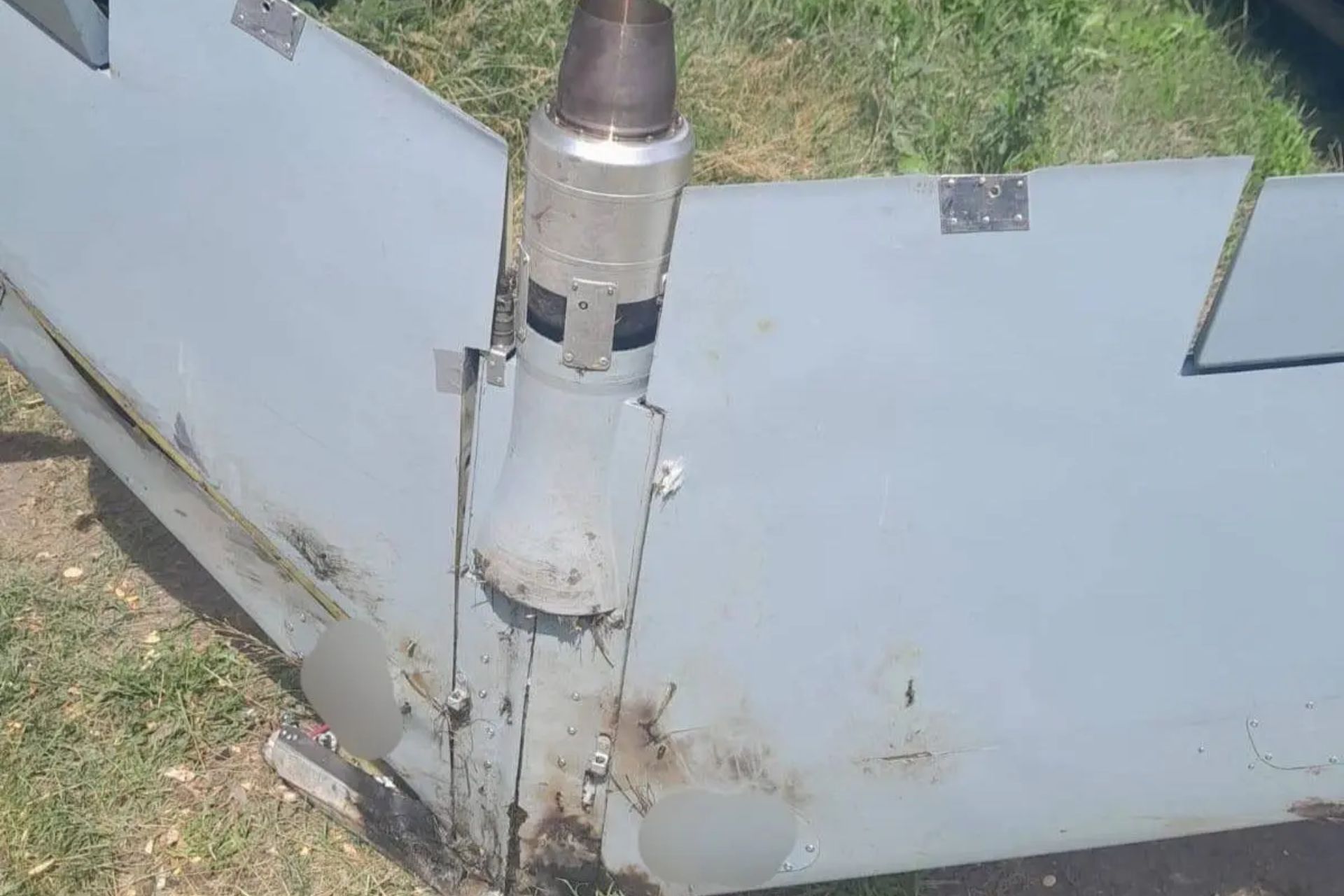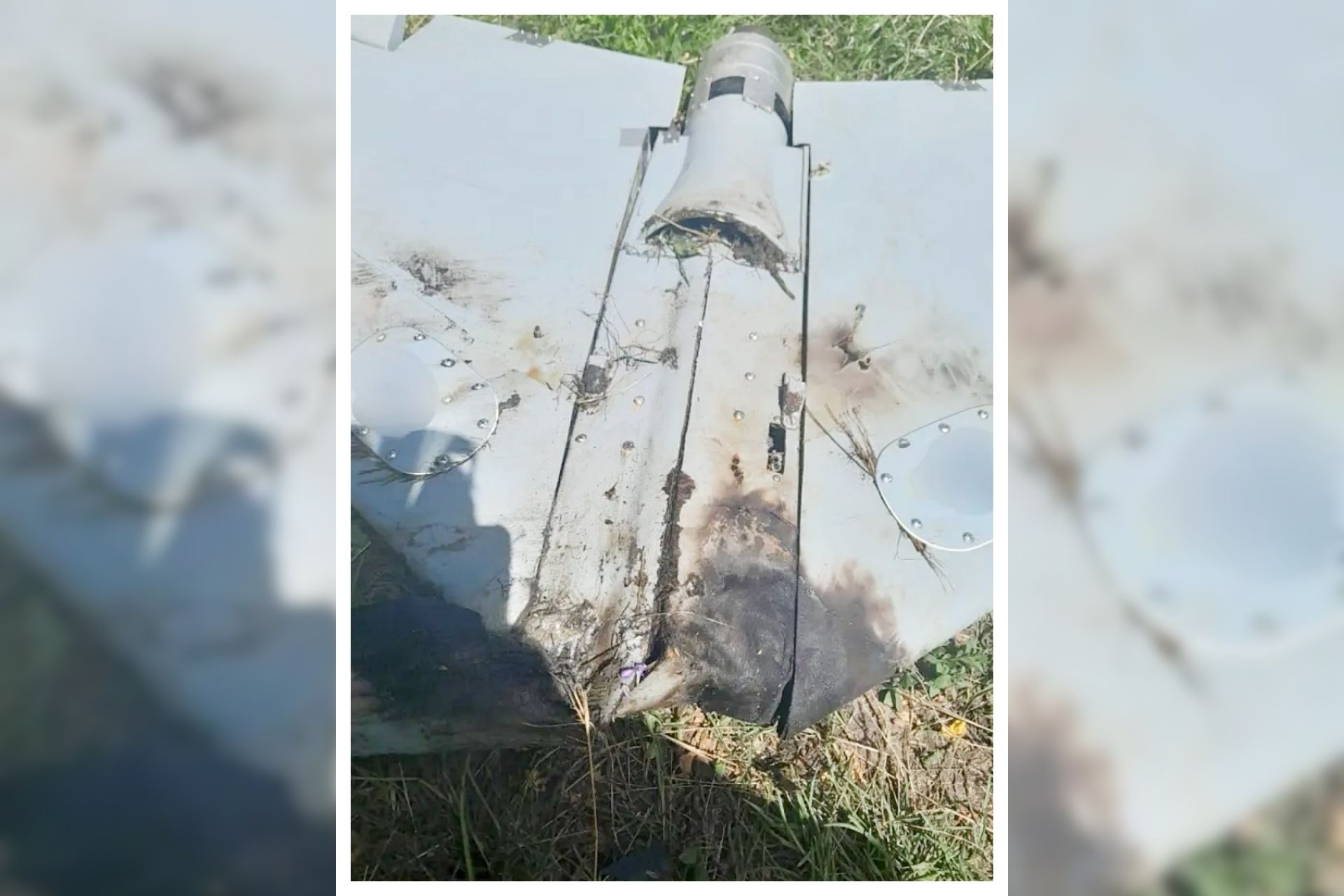Ukrainian troops down mysterious Russian jet-powered drone

{loadposition bannertop}
{loadposition sidebarpub}
Ukrainian troops successfully intercepted a mysterious new type of Russian jet-powered drone, marking the first appearance of this unmanned aerial vehicle (UAV) model on the battlefield. The incident occurred on August 30 during one of the latest drone attacks carried out by Russia against Ukraine. This drone, previously unknown to the public and military analysts, surprised many with its novel configuration.Follow Army Recognition on Google News at this link
Downed mysterious Russian UAV (Picture source: Ukrainian fighters )
The downed drone is described as a jet-powered aircraft following the “flying wing” aerodynamic configuration, indicating a design focused on stealth and speed. Notably, the UAV carried no weapons or visible reconnaissance equipment, suggesting it might have been used as a decoy or to test Ukrainian air defenses rather than for direct engagement.
The construction of this drone suggests that it is not a high-end factory product, but rather a more rudimentary, possibly experimental model. This is corroborated by Ukrainian officials who stated that the drone seems quite rudimentary and exhibits many flaws.
The absence of surveillance equipment or armed devices on this drone has led several military analysts to speculate about its purpose. One of the most likely theories is that this drone was designed to act as a decoy. In other words, it could have been used by Russian forces to test and probe Ukrainian air defenses, forcing them to reveal their positions or exhaust their munitions while minimizing the risks to more valuable and sophisticated equipment.
This approach to asymmetric warfare, where low-value drones are sacrificed to obtain strategic information or provoke a disproportionate response from the adversary, is not new, but the use of a jet-powered drone in this role is. The use of such a device could indicate a new phase in the drone war, where rapid innovation and improvised solutions take precedence over conventional strategies.
The emergence of this jet-powered drone, with its simple yet potentially effective design, underscores the rapid evolution of the conflict in Ukraine, where both sides are constantly seeking to adapt and innovate. For Ukraine, this interception represents both a success and a warning: while the air defenses have proven their effectiveness by shooting down this aircraft, they must now prepare to face an even wider range of threats, including unarmed jet-powered drones used strategically.
This event also highlights the challenges faced by military analysts and intelligence services, who must understand and anticipate the new tactics and technologies employed by Russia. The downed drone could be just the first in a series of experiments aimed at destabilizing Ukrainian defenses and creating new opportunities on the battlefield.
One possible scenario is an attempt to saturate the airspace with small, inert, and inexpensive drones, thereby forcing defense systems to rearm and focus on intercepting this threat. Simultaneously, alongside such a saturation attack, a real airstrike on high-value targets could be launched from another direction. Today, such targets include electrical infrastructure or garrisons of foreign soldiers.
Other view of downed Russian Drones (Picture source: Ukrainian fighters)

{loadposition bannertop}
{loadposition sidebarpub}
Ukrainian troops successfully intercepted a mysterious new type of Russian jet-powered drone, marking the first appearance of this unmanned aerial vehicle (UAV) model on the battlefield. The incident occurred on August 30 during one of the latest drone attacks carried out by Russia against Ukraine. This drone, previously unknown to the public and military analysts, surprised many with its novel configuration.
Follow Army Recognition on Google News at this link
Downed mysterious Russian UAV (Picture source: Ukrainian fighters )
The downed drone is described as a jet-powered aircraft following the “flying wing” aerodynamic configuration, indicating a design focused on stealth and speed. Notably, the UAV carried no weapons or visible reconnaissance equipment, suggesting it might have been used as a decoy or to test Ukrainian air defenses rather than for direct engagement.
The construction of this drone suggests that it is not a high-end factory product, but rather a more rudimentary, possibly experimental model. This is corroborated by Ukrainian officials who stated that the drone seems quite rudimentary and exhibits many flaws.
The absence of surveillance equipment or armed devices on this drone has led several military analysts to speculate about its purpose. One of the most likely theories is that this drone was designed to act as a decoy. In other words, it could have been used by Russian forces to test and probe Ukrainian air defenses, forcing them to reveal their positions or exhaust their munitions while minimizing the risks to more valuable and sophisticated equipment.
This approach to asymmetric warfare, where low-value drones are sacrificed to obtain strategic information or provoke a disproportionate response from the adversary, is not new, but the use of a jet-powered drone in this role is. The use of such a device could indicate a new phase in the drone war, where rapid innovation and improvised solutions take precedence over conventional strategies.
The emergence of this jet-powered drone, with its simple yet potentially effective design, underscores the rapid evolution of the conflict in Ukraine, where both sides are constantly seeking to adapt and innovate. For Ukraine, this interception represents both a success and a warning: while the air defenses have proven their effectiveness by shooting down this aircraft, they must now prepare to face an even wider range of threats, including unarmed jet-powered drones used strategically.
This event also highlights the challenges faced by military analysts and intelligence services, who must understand and anticipate the new tactics and technologies employed by Russia. The downed drone could be just the first in a series of experiments aimed at destabilizing Ukrainian defenses and creating new opportunities on the battlefield.
One possible scenario is an attempt to saturate the airspace with small, inert, and inexpensive drones, thereby forcing defense systems to rearm and focus on intercepting this threat. Simultaneously, alongside such a saturation attack, a real airstrike on high-value targets could be launched from another direction. Today, such targets include electrical infrastructure or garrisons of foreign soldiers.

Other view of downed Russian Drones (Picture source: Ukrainian fighters)







